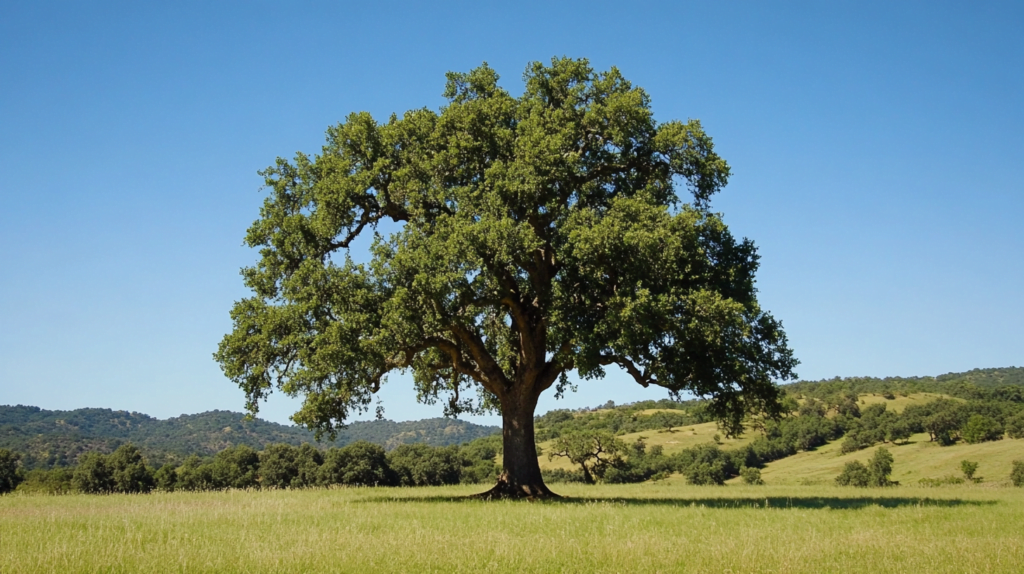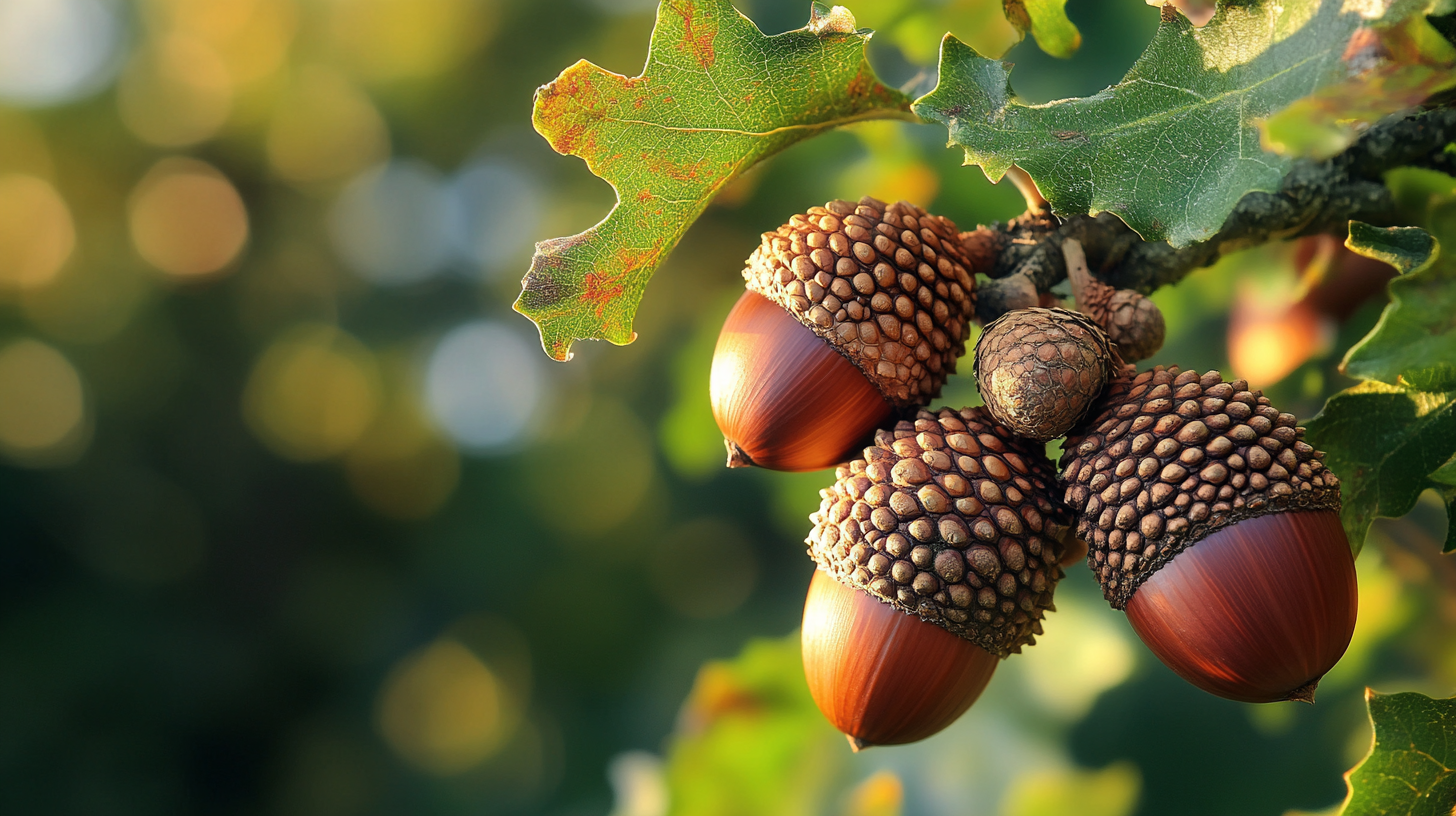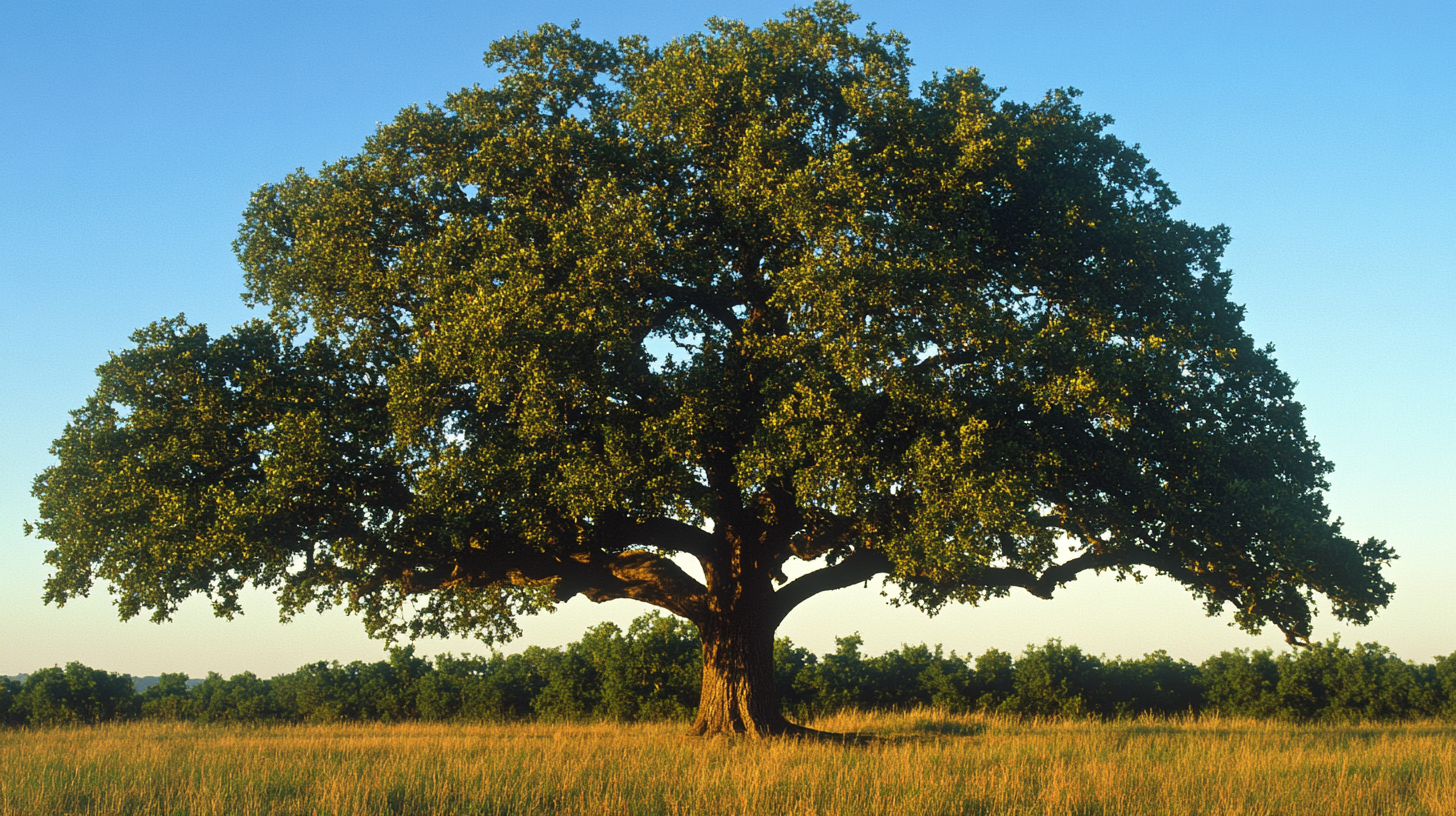Table of Contents
Oak trees are the majestic giants of the forest, standing tall and proud in landscapes across the globe. With over 600 species worldwide and about 90 in North America alone, these hardy trees have captivated humans for centuries. Whether you’re a nature enthusiast, a budding arborist, or simply curious about the trees in your backyard, learning to identify different types of oak trees can be a rewarding experience. In this comprehensive guide, we’ll explore the key characteristics that will help you recognize various oak species and appreciate their unique features.
Basic Oak Tree Characteristics
Before diving into specific species, let’s look at the general traits that define oak trees:
Tree Structure and Growth Patterns
Oak trees are known for their impressive size and longevity. They typically have a broad, spreading canopy and can live for hundreds of years. Most oaks grow slowly but steadily, developing a robust trunk and strong branches over time. Their growth patterns can vary depending on the species and environmental conditions:
- Height: Oak trees can range from 30 to over 100 feet tall, depending on the species.
- Spread: The canopy spread can be as wide as 80 feet in some mature specimens.
- Growth rate: On average, oaks grow about 1-2 feet per year, but some species can grow faster.
Leaf Characteristics
Oak leaves are one of the most distinctive features for identification. While there’s considerable variation among species, most oak leaves share some common traits:
- Lobes: Many oak leaves have deep lobes, which are rounded projections along the leaf edge.
- Arrangement: Leaves are typically arranged alternately on the branches.
- Texture: The texture can range from smooth and waxy to rough and leathery.
- Color: Most oak leaves are dark green on top and lighter underneath, with some species showing dramatic color changes in fall.
Acorn Production
All oak trees produce acorns, which are their fruit and seeds. Acorns are a crucial food source for wildlife and can also help in identification:
- Size: Acorns can range from about 1/2 inch to 2 inches in length.
- Shape: They’re typically oval or oblong with a cap (cupule) at one end.
- Maturation time: Depending on the species, acorns take either one or two years to mature.
Bark Features
Oak bark is another key identifier, though it can vary significantly with age and species:
- Texture: Young oaks often have smooth bark, while older trees develop deep furrows and ridges.
- Color: Bark color ranges from light gray to dark brown or nearly black.
- Patterns: Some species have distinctive bark patterns, like the diamond-shaped fissures of white oak.
The Two Main Oak Groups: Red Oaks vs. White Oaks
Oak trees are broadly categorized into two main groups: red oaks and white oaks. Understanding the differences between these groups is crucial for identification:
Red Oaks
Red oaks are characterized by:
- Leaf shape: Pointed lobes with bristle tips
- Bark: Generally smoother, with shallow furrows
- Acorns: Take two years to mature, often with a bitter taste due to high tannin content
- Wood: More porous, often with a pinkish tint
White Oaks
White oaks have these distinguishing features:
- Leaf shape: Rounded lobes without bristles
- Bark: Usually rougher, with deep furrows and ridges
- Acorns: Mature in one year, generally sweeter due to lower tannin content
- Wood: Less porous, often with a light color
Here’s a comparison table to help visualize the differences:
| Feature | Red Oaks | White Oaks |
|---|---|---|
| Leaf tips | Pointed with bristles | Rounded without bristles |
| Bark texture | Smoother | Rougher |
| Acorn maturation | 2 years | 1 year |
| Wood porosity | More porous | Less porous |
Identifying Oak Trees by Leaves
Leaf identification is often the easiest way to distinguish between oak species. Here’s what to look for:
Leaf Shape and Lobes
- Red oaks: Typically have leaves with sharp, pointed lobes and bristle tips. The sinuses (spaces between lobes) are often deep.
- White oaks: Usually have leaves with rounded lobes and no bristles. The sinuses can be shallow or deep.
Leaf Margins
Pay attention to the edge of the leaf:
- Smooth: Some oaks, like the willow oak, have leaves with smooth edges.
- Toothed: Species like the chestnut oak have leaves with small, tooth-like projections.
- Lobed: Most oaks have distinctly lobed leaves, but the depth and shape of lobes vary.
Leaf Size and Color
- Size: Oak leaves can range from about 2 to 10 inches in length.
- Color: While most are green in summer, fall colors can be a key identifier. Red oaks often turn deep red or burgundy, while white oaks may turn brown or yellow.
Seasonal Changes
Remember that oak leaves change throughout the year:
- Spring: New leaves often emerge with a reddish or bronze tint.
- Summer: Leaves reach their mature color, usually dark green.
- Fall: Colors change dramatically, offering another identification opportunity.
- Winter: Some oaks are marcescent, meaning they retain dead leaves through winter.
Recognizing Oak Trees by Bark
While leaf identification is useful, bark can be a year-round identifier. Here’s what to look for:
Texture Differences
- Young trees: Generally have smooth bark.
- Mature trees: Develop distinctive textures:
- White oaks often have a scaly or flaky appearance.
- Red oaks tend to have smoother bark with shallow furrows.
Color Variations
Bark color can range from light gray to nearly black:
- White oak: Often light gray to ashy gray.
- Red oak: Usually darker, ranging from reddish-brown to dark gray.
- Black oak: Can be very dark, almost black in mature trees.
Age-related Changes
As oaks age, their bark changes:
- Young trees: Smooth, often with a silvery sheen.
- Middle-aged trees: Begin to develop furrows and ridges.
- Old trees: Deep furrows, thick plates, or shaggy appearance depending on species.
Acorn Identification
Acorns can be a reliable way to identify oak species, especially when combined with other characteristics:
Size and Shape Differences
- Size: Acorns can range from tiny (about 1/2 inch) to quite large (up to 2 inches).
- Shape: Most are oval, but some species have distinctive shapes like the bur oak’s fringed cap.
Cap Characteristics
The cap, or cupule, that partially covers the acorn is a key identifier:
- Coverage: Can range from barely covering the acorn to almost completely enclosing it.
- Texture: May be smooth, scaly, or hairy.
- Edge: Some caps have fringed edges, others are smooth.
Maturation Time
- Red oaks: Acorns take two years to mature.
- White oaks: Acorns mature in one year.
This difference in maturation time means you might see acorns at different stages on the same red oak tree.
Common North American Oak Species and Their Unique Features
Let’s explore some of the most common oak species you might encounter in North America:
White Oak (Quercus alba)
- Leaves: 5-9 rounded lobes, deep sinuses
- Bark: Light gray, scaly plates
- Acorns: Oblong, about 3/4 inch long, with a warty cap
- Habitat: Eastern and central North America
Northern Red Oak (Quercus rubra)
- Leaves: 7-11 pointed lobes with bristle tips
- Bark: Dark gray to black, with smooth ridges
- Acorns: Round, about 1 inch long, with a flat, saucer-like cap
- Habitat: Eastern and central North America
Pin Oak (Quercus palustris)
- Leaves: Deeply lobed with 5-7 bristle-tipped lobes
- Bark: Gray-brown, smooth when young, developing shallow furrows with age
- Acorns: Small, about 1/2 inch long, with a thin, saucer-like cap
- Habitat: Eastern and central United States
Bur Oak (Quercus macrocarpa)
- Leaves: Large, with 5-9 rounded lobes, often with a “mitten” shape
- Bark: Thick, deeply furrowed, gray-brown
- Acorns: Large, up to 2 inches long, with a fringed cap covering half the nut
- Habitat: Central and eastern North America
Live Oak (Quercus virginiana)
- Leaves: Evergreen, oblong, and leathery without lobes
- Bark: Dark brown to nearly black, deeply furrowed
- Acorns: Small, oblong, about 1 inch long
- Habitat: Southeastern United States coastal regions
Oak Tree Identification Tools and Resources
To aid in your oak identification journey, consider using these tools and resources:
Field Guides and Apps
- Field guides: Look for guides specific to your region for the most relevant information.
- Mobile apps: Many plant identification apps use photo recognition technology to help identify trees.
Online Databases and Identification Keys
- USDA Plants Database: Comprehensive information on North American plant species.
- iNaturalist: A citizen science project that can help with identification and tracking observations.
Local Arboretums and Botanical Gardens
Visit local arboretums or botanical gardens to see labeled specimens and learn from experts. Many offer guided tours or workshops on tree identification.
Tips for Successful Oak Tree Identification
To become proficient at identifying oak trees, keep these tips in mind:
- Observe multiple features: Don’t rely on a single characteristic. Look at leaves, bark, acorns, and overall tree shape.
- Consider geographic location: Know which oak species are native or common in your area.
- Note seasonal changes: Observe trees throughout the year to see how their appearance changes.
- Compare similar species: Learn to distinguish between closely related oak species.
- Practice regularly: The more trees you identify, the better you’ll become at recognizing key features.
Common Challenges in Oak Tree Identification
Even experienced naturalists can face challenges when identifying oaks:
Hybrid Oaks
Oaks readily hybridize, creating trees with mixed characteristics. This can make identification tricky, especially in areas where multiple oak species coexist.
Young vs. Mature Tree Differences
Young oak trees can look quite different from their mature counterparts. Bark texture, leaf shape, and overall form can change significantly as a tree ages.
Regional Variations within Species
Environmental factors can cause variations in tree appearance even within the same species. Trees growing in different climates or soil conditions may develop slightly different characteristics.

The Importance of Oak Tree Conservation
As we learn to identify and appreciate oak trees, it’s crucial to understand their ecological significance and the threats they face:
Ecological Significance
Oak trees are keystone species in many ecosystems:
- They provide food and habitat for hundreds of animal species.
- Their deep root systems help prevent soil erosion.
- They play a crucial role in carbon sequestration, helping to mitigate climate change.
Threats to Oak Populations
Several factors threaten oak populations worldwide:
- Climate change: Shifting temperature and precipitation patterns affect oak distribution and health.
- Invasive pests and diseases: Issues like sudden oak death and oak wilt are devastating some populations.
- Habitat loss: Urban development and land-use changes are reducing oak habitats.
How to Support Oak Conservation Efforts
You can contribute to oak conservation by:
- Planting native oak species in your yard or community.
- Supporting local conservation organizations focused on forest preservation.
- Educating others about the importance of oaks in ecosystems.
By learning to identify different types of oak trees, we gain a deeper appreciation for these magnificent trees and their role in our environment. Whether you’re exploring a forest, walking through a park, or simply admiring the trees in your neighborhood, the ability to recognize various oak species adds a new dimension to your connection with nature. So grab a field guide, download an app, and start your oak identification adventure today!




